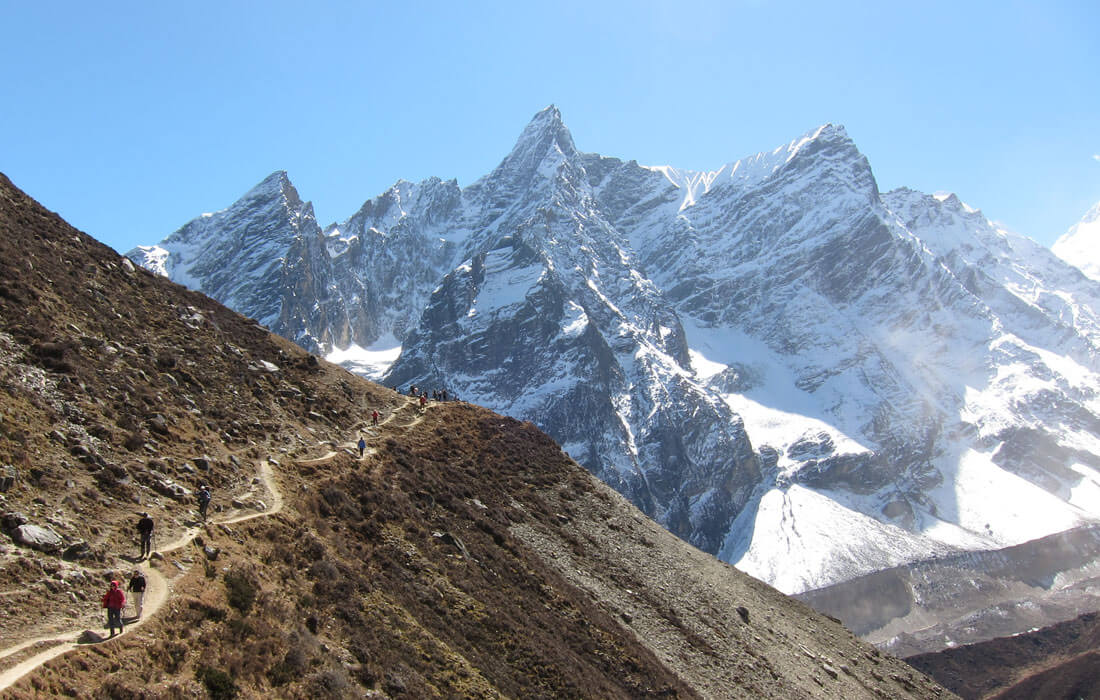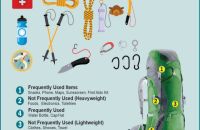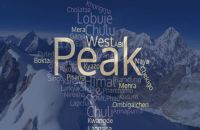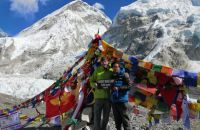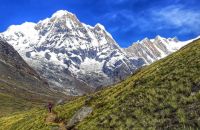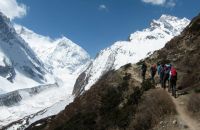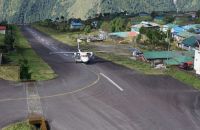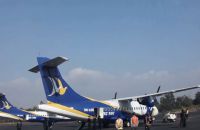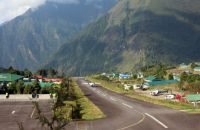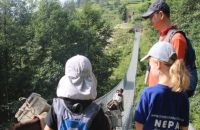Talk with our local travel specialist who can help organize your trip.
Trekking to manaslu region of Nepal - All you need to know
The walking is both exhilarating and challenging and, at least compared to the Everest and Annapurna regions, there are relatively few other trekkers. There are thrilling side trips to glaciers, base camps and tucked away gompas as well as the chance to blaze your own trail in little trodden valleys and up to breezy passes on the border of Tibet.
The Manaslu region didn’t open up to foreign trekkers until the early 1990’s (and the neighboring Tsum valley opened even later) but it becomes an instant hit among those happy with a challenging and less developed trekking area. In fact, talk to someone who has walked in the shadow of Manaslu and they’ll likely tell you that overall this is one of the most rewarding areas to trek in Nepal.
Table of Content
- Best Trekking Season For Manaslu Region
- How Should I Trek In Manaslu And The Tsum Valley?
- Permits For Manaslu And Tsum Valley Trek?
- Is Manaslu And The Tsum Valley A Dangerous Area To Trek?
- How Do I Get To The TrailHeads?
- Tell Me What The Best Things About Trekking In The Manaslu And Tsum Valley Are?
- Main Treks In The Manaslu Region Of Nepal
Best Trekking Season For Manaslu Region

The weather – and likewise the trekking seasons – for the Manaslu region and Tsum Valley is broadly similar to that of the neighbouring Annapurna region. The best trekking season is the dry season running from roughly early-October to late May and the wet season (a bad time to trek) from June to September.
Accordingly, the best time to trek any of the trails around Manaslu and the Tsum Valley is between October and May. But within this time frame there is a little seasonal variation. Overall, October to November and also March and April are the prime months. October and November offer the ideal combination of crystal clear skies, reasonable temperatures and little chance of unexpected rain or snow. But, it’s also the busiest period.
In April flowering rhododendrons light up the forested lower slopes, but the heat is really building up at lower elevations and the air is increasingly hazy. It can get very cold in December and January and the Larkya La pass (5165m), which is the high point of the Manaslu Trek, can often be blocked by snow at this time. In the Tsum Valley, local people might abandon the higher, colder villages at this time. This makes December and January a complicated time to trek higher routes here, but otherwise, it remains dry and the air is very clear so it’s perfectly feasible to trek the lower parts of the Tsum Valley and – so long as the pass is clear of heavy snow and you’re very well equipped for the cold (make sure you have camping gear and food in case you get stuck for a day or so waiting for the snow to clear) then it should also be just about possible to trek the Manaslu Circuit.
The Tsum Valley and the Nupri Valley (the northern part of the Manaslu Circuit and a much more Tibetan-influenced region) sit within the rain shadow of the Himalaya and have some shelter from the monsoon clouds and rain. Even so, very few people trek here in the monsoon: the lower parts of all treks would be rain-soaked, mudslides and avalanches are fairly common and mountain views throughout the region are likely to be obscured. Recommended Trek: Manaslu Circuit and Nar Phu Valley Trek - 22 Days
How Should I Trek In Manaslu And The Tsum Valley?

Unlike the Langtang, Everest and much of the Annapurna regions completely independent trekking is not allowed in the Manaslu Himalaya and the Tsum Valley. All treks in this area have to be organized through a recognized Nepalese tour operator.
Technically, for any of the treks in this region you must be in a party of at least two trekkers and be accompanied by a guide. However, it’s possible to pay for a second ‘ghost’ trekker permit. If the sound of an organized trek puts you off then don’t be. An organized trek can mean a fully-organized camping trek with a bevy of porters, cooks, guides and other camp staff with all the comfort and freedom that this brings with it. Or, it can be as simple as you and a friend with just a solitary guide (though we would at least suggest having a couple of porters to carry your bags), staying in trekking lodges and largely making your schedule up as you go along.
Trekking lodges along the Manaslu Circuit are improving fast. They’re still not up there with the Annapurna and Everest regions, but they’re also not far behind either. For the moment the Tsum valley is all homestays. Not as comfortable for sure but much more interesting. It’s a very good idea to come to the Tsum valley with camping gear as that opens up all kinds of possibilities for interesting overnight side trips. The Rupina La trek and much of the Ganesh Himal trek is camping only.
Permits For Manaslu And Tsum Valley Trek?
For the Manaslu Circuit trek you need a Manaslu Conservation Area Permit and a restricted area permit (first-week Sept-Nov/Dec-Aug US$70/50. Additional days after first week US$10/7). For the Tsum valley you need the same set of permits plus a Tsum valley permit (first-week Sept-Nov/Dec-Aug US$35/25. Additional days after first week US$3.50/2.50).
Must Read: How To Get TIMS Card And Trekking Permits In Nepal
Is Manaslu And The Tsum Valley A Dangerous Area To Trek?

As with all Nepal’s main trekking regions for the most part the Manaslu region and Tsum Valley is a safe area to trek. But, there are some important exceptions and points to keep in mind.
- The Larkya La pass (5165m), which is the highest point on the Manaslu Circuit, is high, cold, remote and often snowbound. It’s very important that on the way up to the pass that you build in a couple of acclimatization days (use these days to do some of the highly enjoyable side-trips. These often turn out to be the highlights of a Manaslu trek). People who don’t add these days often suffer from at least mild altitude problems.
- The Rupina La (4720m) trek is very remote and very rarely walked by trekking parties. Ice and snow is common. If you have an accident or have altitude problems (and the trail gains altitude fast) then you will be on your own. Make sure your guide has a satellite phone (that’s charged up!). This route should only be attempted by experienced trekkers with some basic mountaineering skills.
How Do I Get To The Trail Heads?
There are no flights to trailheads in the Manaslu and Tsum Valley area but getting to the start and endpoints of any of the treks is pretty simple by bus or with a private vehicle organized in either Kathmandu or Pokhara. The trailhead for all the routes described below traditionally started in the town of Gorkha and walked right past the town's magnificent royal palace. Increased road construction over the past few years though means that most people now shave several days off the treks by starting in the small town of Arughat. There are direct buses at least twice daily from Kathmandu otherwise take a bus along the Kathmandu-Pokhara highway and hop off in the town of Malekhu from where local buses and jeeps run fairly frequently to Arughat. Note that the road can be a real mess after heavy rain.
Tell Me What The Best Things About Trekking In The Manaslu And Tsum Valley Are?

The Manaslu Circuit isn’t increasingly touted as ‘Nepal’s best trek’ for nothing and almost everything about trekking in the Manaslu region and Tsum Valley is good.
Larkya La
Wonders never cease on the Manaslu Circuit Trek, but the best part is saved until almost the end. The Larkya La (5165m) might not be the highest trekking pass in the Nepalese Himalaya but it’s certainly one of the most dramatic. It’s a draining climb up to the pass but the reward is a sweeping view over dozens of mountains.
Tsum Valley
Only opened to tourists in 2008, the Tsum valley is an isolated Tibetan realm with beautiful gompas, traditional villages and exciting exploratory treks. It’s considered a baeyul, or ‘hidden paradise land’ in Tibetan culture.
Side Trips
There are some fabulous side trips on both the Manaslu Circuit and the Tsum valley treks and you should allow three or four extra days to enjoy them. Chances are that treks to Manaslu base camp, to the high passes along the Tibet border or to crystalline lakes and atmospheric monasteries will turn out to be the most memorable part of your whole trek.
Village Life
Being a relatively recent edition to the Nepal trekking scene and, for the moment, far less visited than nearby areas, the Manaslu area offers the chance to witness a more traditional village life where agriculture and yak herding plays a more important role in local economies than trekking tourism.
Adventure
This is an area where real, unpackaged adventure is still not just a possibility, but, should you want it, a certainty. Explore the upper ridges of the Tsum Valley, be one of the first to delve into the gorges of the Ganesh Himal and admire the impressive cirque, veer off down side tracks to monasteries and base camps little known to the outside world. With a tent, some food and a good local guide you can help fill in some of the blanks on the trekking map.
Rupina La
Not one for casual hikers, but for the well-equipped and experienced the Rupina La trek will take you into an uninhabited wilderness with stirring mountain views and a sometimes hair-raising pass crossing.
Main Treks In The Manaslu Region Of Nepal
Manaslu Circuit Trekking

When the Manaslu Circuit first opened to trekking tourism back in the early 1990’s it became an instant favourite. The first trekkers to the region returned with tales of stupendous mountain scenery, fascinating and varied village life and challenging walking. Within no time at all it started to gain a reputation as the ‘new’ Annapurna Circuit and perhaps the single best trek in Nepal.
Today, after twenty-five years of trekkers passing through, the Manaslu Circuit continues to live up to the hype. This walk really does have it all. The trail begins in the hot lowlands and passes through Hindu villages, fields of wheat and, over the course of the next two weeks the scenery – and the people – gradually change. Hills turn to intimidating mountains, fields of wheat mutate into pine forests, and these in turn fade away with increasing altitude until all the walker is left with are massive glaciers and high mountain wastelands. But, it’s not just the scenery that changes so dramatically.
The people and cultures also change. In the lowlands, Hinduism predominates and up high the prayer wheels of Tibetan Buddhism take over. Not just does the Manaslu Circuit offer interest and thrills all along the main route, but there are also several exciting day trips off the main trail that are not just scenic and cultural detours but also serve as a good way of acclimatizing for higher altitudes. And they don’t come much more challenging than the crossing of the Larkya La pass (5165m). It’s the highest point on this trek and one of the most thrilling pass crossings in Nepal. All up, this is a trek with a real sense of journey and achievement and is fully worthy of all the praise heaped upon it.
It should be borne in mind though that although the Larkya La is a little lower than similar passes on the Annapurna Circuit or Everest Base Camp this is generally a harder trek and facilities are much more basic than on the Annapurna or Everest trails – don’t expect apple pie and Wi-Fi at the end of the day.
If time allows it’s highly rewarding to tack the Tsum Valley trek onto the Manaslu Circuit. And, should you want to walk on and on then the Manaslu Circuit (which is almost always walked in an anti-clockwise direction due to acclimatization reasons) finishes on the main Annapurna Circuit so if one high pass isn’t enough for you then you can carry on up and over the Thorung La and down to Jomsom (from where another world of possibilities opens up).
|
Difficulty: |
Difficult |
|
Trek Duration: |
14-18 days (it’s best to allow 18 days in order to enjoy the many side trips and to acclimatize properly). |
|
Max. Elevation: |
5165m |
|
Accommodation: |
Trekking lodges or camping. |
|
Start/End Point: |
Arughat or Soti Khola/Dharapani or Besi Sahar |
Suggested Read: Manaslu Circuit Trek - 8 Reasons And Amazing Facts
Tsum Valley Trekking

Tucked up to the northeast off the main Manaslu Circuit, the Tsum Valley has only been open to trekkers for a decade. Considered a baeyul (mystical hidden paradise land) in Tibetan culture and legend, big mountain views aren’t so much the attraction here (though if you have camping gear then strike out to the furthest northeast corners of the valley – beyond the last village – to the high passes that lead into Tibet). Instead, a Tsum Valley trek is all about venturing off the beaten path and discovering an older pace of life where the farming seasons and Tibetan Buddhism are all important. That said the views of deep forests, fields of tsampa, and empty tundra giving way to distant Tibetan mountain peaks is still out of this world.
While there is a generally accepted set trail up and down the valley (that takes about a week) much of the delight of the Tsum Valley is in making your own routes. Add in overnight excursions to the frozen Tibetan plateau at the head of the valley and veer off to explore Milarepa’s cave, Lungdang gompa and the stunning Ganesh Himal base camp and you’ll find yourself wanting to devote at least ten to twelve days to this fascinating region. All up though, the Tsum valley rewards time and patience and the more of it you have the more you’ll be enchanted by the valley.
Note that the trail head for this trek is Lokpa which in itself is two to three days walk along the Manaslu Circuit from Arughat and you need to add this into the minimum time frame below. For the ultimate Tsum and Manaslu experience when you’ve finished in Tsum head on up the Manaslu Circuit and over the Larkya La.
For the moment this is a lightly visited trekking area and accommodation remains basic but highly authentic. In the cold depths of winter the inhabitants of the higher villages may shut up house and head for warmer valleys (or even Kathmandu and Pokhara). At such times you should come prepared with camping gear.
|
Difficulty: |
Moderate |
|
Trek Duration: |
7-17 days |
|
Max. Elevation: |
3709m for the main trek; Around 4200m for side trips. |
|
Accommodation: |
Homestays, teahouse or camping. |
|
Start/End Point: |
Lokpa |
Rupina La Trekking
For those on organized camping treks then a fabulous alternative route for the first half of the Manaslu Circuit is to start trekking from Chanaute or Barpak (both north of the town of Gorkha) and cross over the Rupina La (4720m; April-November only) to join the Manaslu Circuit at Lokpa (which is also the start point for the Tsum valley trek). This is a real wilderness trek with around five days away from all human habitation bar the odd herder with his yaks. The pass is notoriously prone to fast and dramatic weather changes. Snow is common and, on the lee side of the pass you have to pick your way carefully down the side of a glacier. It’s not a trek for first-time trekkers or those who are ill-equipped. The trail skirts the Gorkha and Boudha Himal and has impressive mountain views.
|
Difficulty: |
Difficult |
|
Trek Duration: |
4-6 days |
|
Max. Elevation: |
4720m |
|
Accommodation: |
teahouse, camping |
|
Start/End Point: |
Chanaute or Barpak/Lokpa |
Ganesh Himal Trekking
Considering their proximity to Kathmandu, the Ganesh Himal, which culminates with Ganesh I at 7422m, are remarkably little known. In fact, they’re probably some of the least known mountains in Nepal and there’s no set, established route as such and even less in the way of a trekking infrastructure. This of course means that anyone wishing to explore this tight knot of glaciated peaks has to be totally self-sufficient with ample food and camping gear (though there are any villages along many parts of the trails and you might be able to organize homestay style accommodation).
There are two general access points. The first – and easiest – is to head into the Tsum valley but then spiral off southeast at the village of Domje into the Khangi Danda valley and the Ganesh Himal Base Camp. This is only a short two-three day detour of the Tsum Valley trek but rewards with views of a great cirque of peaks that’s said to rival the views from Annapurna Base Camp. The other, wilder and much longer trek, but one that gives a more in-depth Ganesh Himal experience tackles the southern slopes. There are several start points but Arughat is a popular kick-off location. The trail then wends through the Middle Hills for a week until finally reaching the Dorba Danda viewpoint. Most people then descend, head east and then climb up again to the Paldor Base Camp (4280m) or even the high camp (4980). Each trekking agency will create their own variation of this long (16-19 days) trek. Due to the remote terrain and general lack of knowledge of the area this trek is not recommended for a first time Himalayan experience.
|
Difficulty: Moderate |
Difficult |
|
Trek Duration: |
3-19 days |
|
Max. Elevation: |
Around 4980m |
|
Accommodation: |
homestay, local teahouse or Camping |
|
Start/End Point: |
Multiple options. |
- Written by: Stuart Butler
- Updated: Tuesday Feb 2, 2021

